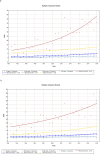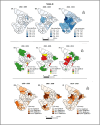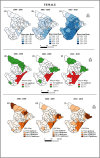Spatial-temporal pattern of colorectal cancer mortality in a Northeastern Brazilian State
- PMID: 38394082
- PMCID: PMC10889879
- DOI: 10.1371/journal.pone.0298100
Spatial-temporal pattern of colorectal cancer mortality in a Northeastern Brazilian State
Abstract
Colorectal cancer (CRC) is one of the most common cancer types worldwide. Its increasing mortality trends, especially in emerging countries, are a concern. The aim of this study was to analyse mortality trends and spatial patterns of CRC in the state of Sergipe, Brazil, from 1990 to 2019. Trends were calculated using data from the Online Mortality Atlas and Joinpoint Regression Program 4.8.0.1. Spatial analyses were performed using the empirical Bayesian model and Moran indices calculated by TerraView 4.2.2 between 1990 to 1999, 2000 to 2009 and 2010 to 2019. A total of 1585 deaths were recorded during the study period, with 58.42% among females. Trends were increasing and constant for both sexes and all age groups studied. The highest mean annual percent change was 6.2 {95% Confidence interval (CI) 3.4;9.0} for males aged +65 years and 4.5 (95% CI 3.2;5.8) for females aged 50-64 years. There was positive spatial autocorrelation for both sexes in all periods studied when using the Moran index for Bayesian rates. In summary, a consistent trend of increasing colorectal cancer (CRC) mortality has been observed overall. Nevertheless, an altered spatial distribution among males has emerged over the studied period.
Copyright: © 2024 Moura et al. This is an open access article distributed under the terms of the Creative Commons Attribution License, which permits unrestricted use, distribution, and reproduction in any medium, provided the original author and source are credited.
Conflict of interest statement
The authors have declared that no competing interests exist.
Figures



References
-
- Cancer Today [Internet]. [cited 2023 Feb 22]. Available from: https://gco.iarc.fr/today/online-analysis-pie
-
- Santos M de O, Lima FC da S de, Martins LFL, Oliveira JFP, Almeida LM de, Cancela M de C. Cancer Incidence Estimate in Brazil, 2023–2025. Braz. J. Cancerol. 2023;69(1):e-213700.
-
- National Cancer Institute—INCA. Cancer Statistics. [Internet]. [cited 2023 Feb 22] Available from: https://www.gov.br/inca/pt-br/assuntos/cancer/numeros
MeSH terms
LinkOut - more resources
Full Text Sources
Medical

